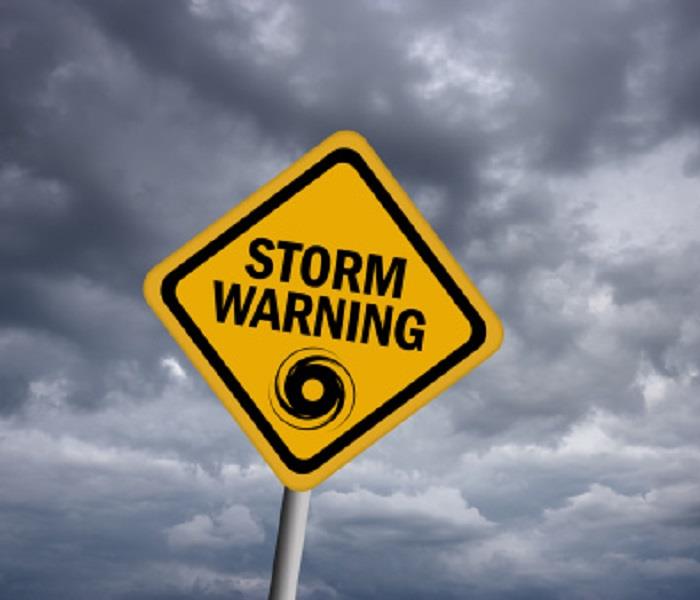Stay Prepared: Hurricane Season Doesn’t End with Summer
9/15/2014 (Permalink)
Eatontown, N.J. -- Hurricane season officially begins each year on June 1, but unlike firemen’s fairs, cookouts and fun at the beach, the season for hurricanes doesn’t end along with the summer.
As a new school year begins, now may be a good time to check your stock of batteries, bottled water and other emergency supplies that may be needed should New Jersey experience an autumn hurricane.
While storm frequency tends to peak in August and September, hurricane season in the United States extends to November 30, and while the risk of a Thanksgiving storm may seem remote, it could happen.
In 2012, Superstorm Sandy only missed it by a few weeks.
Sandy made landfall in New Jersey as a tropical cyclone on October 29, flooding coastal communities, taking down trees, tearing up infrastructure and demolishing homes and businesses throughout the state. Forty New Jersey residents lost their lives.
Two years later, the ongoing expenses of repair, rebuilding and recovery from Sandy have made it the second costliest storm in United States history after Katrina, an August 29 storm that devastated New Orleans and the Gulf Coast in 2005.
Like Sandy, many of the most destructive storms in United States history have occurred after Labor Day, causing massive loss of life and property damage in the billions.
On September 8, 1900, a category 4 hurricane engulfed Galveston Island, Texas. Storm tides as high as 15 feet swept away homes and businesses, killing an estimated 8,000 people.
On September 18, 1920, a category 4 hurricane bearing the highest sustained winds ever recorded at that time slammed into Miami Beach and downtown Miami. Believing the storm was over, thousands of people emerged from their homes during a half-hour lull at the eye of the storm and were trapped without shelter as it regained its ferocity. Every building in downtown Miami was either damaged or destroyed and hundreds of people were killed. The storm then crossed into the Gulf of Mexico, where it destroyed virtually every pier, vessel and warehouse on the Pensacola coast.
In the end, more than 800 people were reported missing after the storm and though records are incomplete, the Red Cross recorded 373 deaths and 6,381 injuries as a result of the hurricane.
On September 20 and 21, 1938, a fast-moving hurricane struck the Mid-Atlantic and New England with such force that thousands of people were taken by surprise. On Long Island, some 20 people watching an afternoon movie at a local cinema were swept out to sea and drowned. One of the victims was the theater’s projectionist. In downtown Providence, Rhode Island, flood waters rapidly flooded streets, submerging automobiles and street cars as their occupants fled to the high floors of office buildings to escape drowning. The record-breaking storm was responsible for 600 deaths, causing $308 million in damage in the midst of the Great Depression.
On October 14, 1954, Hurricane Hazel made landfall as a Category 4 hurricane near Calabash, North Carolina, inundating the coastline with an 18-foot storm surge on a lunar high tide. When the storm passed, only 5 of 357 buildings in Long Beach, North Carolina were still standing. The Raleigh, North Carolina Weather reported that “all traces of civilization on the immediate waterfront between the state line and Cape Fear were practically annihilated." Nineteen people were killed in North Carolina, with several hundred more injured; 15,000 homes were destroyed and another 39,000 were damaged.
On September 11, 1960, Hurricane Donna barreled across Florida, then traveled east through North Carolina, the Mid-Atlantic states and New England, causing $387 million in damage in the United States and $13 million elsewhere along its path.
Accounts like the ones above illustrate the importance of making a plan to protect your family and property from the potentially devastating effects of a hurricane or tropical storm.
With that in mind, why not take a minute to inventory your emergency supplies and schedule a trip to the store to stock up on items that you may need in an emergency.
The Federal Emergency Management Agency’s website, www.ready.gov, has as wealth of information on how to plan, prepare and protect your family should another disaster like Sandy occur in the coming months.
FEMA's mission is to support our citizens and first responders to ensure that as a nation we work together to build, sustain, and improve our capability to prepare for, protect against, respond to, recover from, and mitigate all hazards.




 24/7 Emergency Service
24/7 Emergency Service
